In July of 1776, bells rang out across the country as criers publicly read the text of one of the most important documents in American history: the Declaration of Independence.
Its publication would precede a global war that resulted in the founding of a new nation. It inspired thousands to participate in the fight for freedom and divided the population with its rhetoric. Eventually, it would become part of the mythos of the founding of the nation and inspire dozens of stories related to its creation and purpose.
A prime example is the movie National Treasure which shows Nicolas Cage attempting to steal the Declaration of Independence from the National Archives. Why? Because it supposedly has a hidden message from a shadowy society the Founders were a part of.

The Pen Heard Around the World
A well-known myth about the Declaration of Independence asserts that the Liberty Bell was cracked in Philadelphia the day the Declaration was signed. However, historians have proven this false as the Declaration was not widely shared the day it was signed.
So, bells would not have been celebrating the news. (Also, dating on the bell itself found that it was not cracked until decades later).
But by July 8, the text of the Declaration had been printed and shared across the colonies. As the text was read aloud in crowds, the division of the colonies began. The American Revolution began brewing.
Spreading the Revolution
John Dunlap was the man responsible for spreading the news. Dunlap was a printer who lived in Philadelphia. He stayed up late into the night on July 4 printing copies of the Declaration to disperse across the colonies.
It is unknown what exactly he was copying. Some say it was the document itself, others say it may have been Jefferson’s drafted copy.
But Dunlap printed an unknown number of copies to be read to the public in town squares or for military leaders to share with their troops. He was sometimes rushing so quickly that the papers would be folded before the ink could even dry.
This first printing of the Declaration of Independence has become extremely valuable. Only twenty-five are known to still survive and are mostly housed in museums across the globe.
A Flea Market Bargain Buy
One of these rare copies was found in 1989 in Adamstown, Pennsylvania under unexpected circumstances. A financial analyst from Philadelphia was visiting town and browsing the local flea market when he stumbled across a framed painting.
Although he was not a fan of the painting itself, he liked the frame that it was housed in. So he purchased the item for 4 dollars. When he returned home and attempted to remove the painting, a small folded piece of paper fell from behind the canvas. It was about the size of a business envelope.
After the frame fell apart, he realized that his purchase was a waste. But he looked closer at what had fallen out of the frame. Written on the back of the paper were the words “Declaration of Independence.”
The man assumed it may have been a 19th-century relic. But a friend who collected Civil War memorabilia convinced him to take it to Sotheby’s, an appraisal and auctioning company for art, jewelry, and other items of great worth.
Perfectly Preserved Print
After getting the document appraised, it was discovered to be one of the original copies of the Declaration of Independence that Dunlap printed on July 4, 1776. The document was in near pristine condition. It had been folded up and left in the painting, forgotten but preserved.
The folding left some creases in the document. And there was evidence that Dunlap had hastily folded it after printing it. Because the first line had left a shadow at the bottom of the page where it touched. But otherwise, it had been perfectly preserved.
There are only 24 other known copies of the first print, many of which have faced some kind of degradation. Selby Kiffer, an American printing specialist who worked on appraising the document, commented that it was quite exciting to find even a partial copy or one with extensive damage.
But to find one in near pristine condition was astounding. It had remained nearly untouched for 200 years, with no restoration or repairs to be found. It was also unframed and unbacked, a rarity amongst the surviving copies that made it more valuable.
A (2.2) Million Dollar Surprise
The man agreed to auction the copy of the Declaration through Sotheby’s. An estimate of its worth assumed it would sell for between 800,000 and 1.2 million dollars.
The previous record for a Declaration sold was from a Sotheby’s auction the previous year. A copy from a wealthy steel family’s heir was sold for 1.6 million dollars.
However, when the document went to auction in 1991 it sold for an astounding 2.2 million dollars (about 5 million dollars today), nearly twice its assumed worth. When the document returned to auction in 2000, it sold for $7.4 million (nearly 13 million dollars today).
He has requested that his identity remain a secret, but the man who found this copy of the Declaration of Independence has left a widely known legacy. He is responsible for the most expensive sale of the Declaration of Independence ever.
Wanting to hide his identity is understandable though. He was able to turn 4 dollars into over 2 million dollars through flea market magic!
References
“The time that a $4 flea market picture frame hid an original copy of the Declaration of Independence.” Newsbreak, January 20, 2023. https://original.newsbreak.com/@anita-durairaj-561241/2897435782676-the-time-that-a-4-flea-market-picture-frame-hid-an-original-copy-of-the-declaration-of-independence.
Reif, Rita. “Declaration of Independence Found in a $4 Picture Frame.” The New York Times, April 3, 1991: C11. https://www.nytimes.com/1991/04/03/arts/declaration-of-independence-found-in-a-4-picture-frame.html.
Muzdakis, Madeleine. “Perfectly Preserved Declaration of Independence Found Under a $4 Painting.” My Modern Met, May 19, 2023. https://mymodernmet.com/declaration-of-independence-found/.

